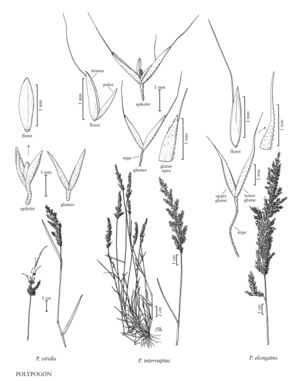familyPoaceae
subfamilyPoaceae subfam. Pooideae
tribePoaceae tribe Poeae
genusPolypogon
speciesPolypogon elongatus
Difference between revisions of "Polypogon elongatus"
Common names: Southern beardgrass
Treatment appears in FNA Volume 24. Treatment on page 663.
FNA>Volume Importer |
imported>Volume Importer |
||
| (5 intermediate revisions by 2 users not shown) | |||
| Line 26: | Line 26: | ||
-->{{#Taxon: | -->{{#Taxon: | ||
name=Polypogon elongatus | name=Polypogon elongatus | ||
| − | |||
|authority=Kunth | |authority=Kunth | ||
|rank=species | |rank=species | ||
| Line 33: | Line 32: | ||
|basionyms= | |basionyms= | ||
|family=Poaceae | |family=Poaceae | ||
| + | |illustrator=Cindy Roché | ||
| + | |illustration copyright=Utah State University | ||
|distribution=Ariz.;Colo.;Tex. | |distribution=Ariz.;Colo.;Tex. | ||
|reference=None | |reference=None | ||
| Line 38: | Line 39: | ||
|publication year= | |publication year= | ||
|special status= | |special status= | ||
| − | |source xml=https:// | + | |source xml=https://bitbucket.org/aafc-mbb/fna-data-curation/src/200273ad09963decb8fc72550212de541d86569d/coarse_grained_fna_xml/V24/V24_935.xml |
|subfamily=Poaceae subfam. Pooideae | |subfamily=Poaceae subfam. Pooideae | ||
|tribe=Poaceae tribe Poeae | |tribe=Poaceae tribe Poeae | ||
Latest revision as of 16:26, 11 May 2021
Plants perennial, often flowering the first year. Culms to 100 cm, erect or decumbent at the base. Sheaths smooth, glabrous; ligules 4-8 mm, scabridulous, lacerate; blades 10-30 cm long, 4-15 mm wide. Panicles 10-30 cm, erect or nodding, interrupted, dense; pedicels not developed; stipes 1.5-2.5 mm. Glumes 3-5 mm, hispidulous, tapering from about midlength to the acute apices, apices unlobed, awned, awns 1-3 mm; lemmas about 1.5 mm, awned, awns 1-2 mm, arising from above midlength; paleas 1/2 - 2/3 as long as the lemmas; anthers 0.5-0.7 mm. 2n = 28, 56.
Distribution
Ariz., Colo., Tex.
Discussion
Polypogon elongatus is native from Mexico to Argentina. It now grows at scattered locations in the Flora region, primarily in California.
Selected References
None.
Lower Taxa
None.
